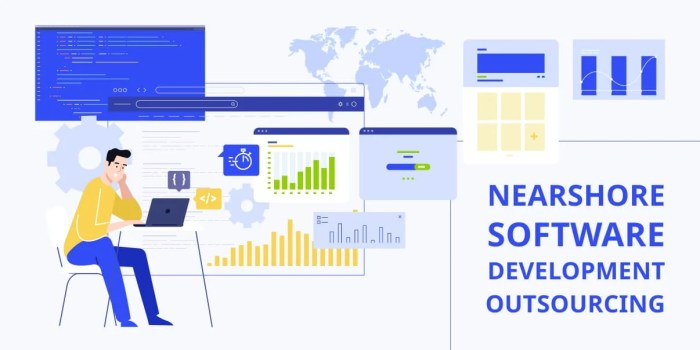In today’s dynamic business landscape, leveraging external expertise is often crucial for success. Software development, a complex and ever-evolving field, is no exception. Outsourcing offers a viable solution, and among the various outsourcing models, nearshore software development has emerged as a compelling option for many companies. This detailed guide explores the intricacies of nearshore outsourcing, outlining its benefits, challenges, and best practices. We’ll delve into key considerations for selecting a nearshore partner and provide actionable insights to help you make informed decisions.
What is Nearshore Software Development Outsourcing?
Nearshore software development outsourcing involves contracting with a software development company located in a geographically proximate country. Unlike offshore outsourcing, which often involves significant time zone differences and cultural disparities, nearshore outsourcing typically takes place in a neighboring country or region, minimizing these challenges. This proximity offers numerous advantages, including easier communication, reduced travel costs, and potentially greater cultural alignment.
Key Characteristics of Nearshore Outsourcing
- Geographical Proximity: The primary characteristic is the close geographical location of the outsourcing partner.
- Time Zone Similarity: Reduced time zone differences facilitate smoother communication and collaboration.
- Cultural Affinity: Often, nearshore partners share similar cultural values and business practices, leading to better understanding and collaboration.
- Easier Travel and On-site Visits: Physical proximity makes travel for meetings and collaboration significantly easier and more cost-effective.
- Stronger Regulatory Alignment: Nearshore partners often operate under similar legal and regulatory frameworks, simplifying compliance.
Benefits of Nearshore Software Development
Numerous benefits make nearshore outsourcing an attractive option for businesses of all sizes. These advantages often outweigh the potential drawbacks, particularly for companies prioritizing efficient communication and collaboration.

Improved Communication and Collaboration
The reduced time zone differences and geographical proximity facilitate seamless communication and collaboration. This leads to quicker response times, faster problem-solving, and a more agile development process. Regular in-person meetings become more feasible, fostering stronger relationships and a greater sense of teamwork.
Cost-Effectiveness
While not as drastically cheaper as offshore outsourcing, nearshore development still offers significant cost savings compared to in-house development. Labor costs in nearshore locations are typically lower than in developed countries, providing a balance between cost savings and quality.
Faster Time to Market
Efficient communication and collaboration contribute to faster project completion times. The reduced logistical complexities and cultural barriers associated with nearshore outsourcing can significantly shorten the time it takes to bring a software product to market.
Access to Specialized Skills
Nearshore locations often possess a skilled and specialized workforce in specific areas of software development. This allows companies to access talent pools that might be unavailable or prohibitively expensive in their own country.
Enhanced Quality Control
The closer proximity facilitates more effective quality control measures. Regular face-to-face meetings and on-site visits allow for more thorough monitoring of the development process, ensuring adherence to quality standards.
Challenges of Nearshore Software Development
While nearshore outsourcing offers many advantages, it’s crucial to acknowledge potential challenges. Careful planning and due diligence can mitigate these risks.

Language Barriers
Even with geographical proximity, language barriers can still exist. Clear communication strategies and the use of translation tools are crucial for effective collaboration. Selecting a partner with strong English proficiency is vital.
Cultural Differences
While often less pronounced than in offshore outsourcing, cultural differences can still impact communication and collaboration. Understanding and respecting cultural nuances is essential for building strong working relationships.

Legal and Regulatory Compliance
Navigating the legal and regulatory frameworks of the nearshore location requires careful attention. Understanding data privacy laws, intellectual property rights, and employment regulations is crucial to avoid potential legal issues.
Software development outsourcing nearshore offers significant advantages, including reduced time zones differences and easier communication. For businesses seeking a reliable and cost-effective nearshore partner, exploring options like nearshore software development Colombia is a smart move. This approach allows companies to leverage skilled talent while maintaining close collaboration, ultimately enhancing the overall software development outsourcing nearshore experience.
Finding the Right Partner
Selecting a reliable and competent nearshore partner is paramount. Thorough due diligence, including background checks and reference verification, is essential to ensure a successful partnership.
Choosing the Right Nearshore Partner: A Step-by-Step Guide
Selecting the right nearshore partner is a critical decision that significantly impacts project success. Follow these steps to ensure you choose a partner that aligns with your needs and goals.
1. Define Your Requirements
Clearly define your project requirements, including the scope of work, timelines, budget, and desired technical expertise.
2. Research Potential Partners
Research potential nearshore partners, considering factors such as their experience, reputation, and technical capabilities. Online research, industry directories, and referrals can be valuable resources.
3. Evaluate Potential Partners
Evaluate potential partners based on their experience, technical expertise, communication skills, and cultural alignment. Conduct interviews, request references, and review their portfolios.
4. Negotiate Contracts
Negotiate contracts that clearly define the scope of work, payment terms, intellectual property rights, and other important aspects of the partnership.
5. Monitor and Manage the Project
Establish clear communication channels and monitoring mechanisms to track progress, address issues, and ensure the project stays on track.
Nearshore Locations: Popular Choices
Several countries are popular choices for nearshore software development outsourcing. The optimal location depends on your specific needs and priorities.
- Mexico: Offers a blend of cost-effectiveness, skilled developers, and proximity to the US.
- Canada: Provides a high-quality workforce with strong English proficiency and cultural alignment with the US.
- Latin America (e.g., Colombia, Argentina, Brazil): Offers a large pool of talented developers at competitive prices.
- Eastern Europe (e.g., Poland, Ukraine): A growing hub for tech talent, offering a balance of cost and skill.
Frequently Asked Questions (FAQ)
- Q: What are the key differences between nearshore and offshore outsourcing? A: Nearshore outsourcing involves partnering with companies in geographically closer countries, leading to improved communication and collaboration compared to offshore outsourcing, which often involves significant time zone differences.
- Q: How can I ensure the quality of work from a nearshore partner? A: Thorough due diligence, clear communication, regular monitoring, and well-defined quality control measures are essential.
- Q: What are the typical costs associated with nearshore software development? A: Costs vary depending on the location, skills required, and project complexity. However, nearshore outsourcing generally offers cost savings compared to in-house development.
- Q: How can I mitigate the risk of language barriers? A: Choose a partner with strong English proficiency, utilize translation tools, and establish clear communication protocols.
- Q: What are some red flags to watch out for when selecting a nearshore partner? A: Unrealistic pricing, lack of transparency, poor communication, and negative online reviews are all red flags.
Conclusion
Nearshore software development outsourcing offers a compelling solution for businesses seeking to leverage external expertise while minimizing the challenges associated with traditional offshore outsourcing. By carefully considering the benefits, challenges, and best practices Artikeld in this guide, you can make informed decisions and build successful partnerships that drive innovation and growth.
References
While specific URLs aren’t provided due to the dynamic nature of online content, reliable sources for further research include reputable market research firms specializing in the IT outsourcing industry, industry publications like Gartner and Forrester, and government websites providing data on specific nearshore locations.
Call to Action
Ready to explore the potential of nearshore software development for your business? Contact us today for a free consultation to discuss your needs and explore how we can help you find the perfect nearshore partner.
